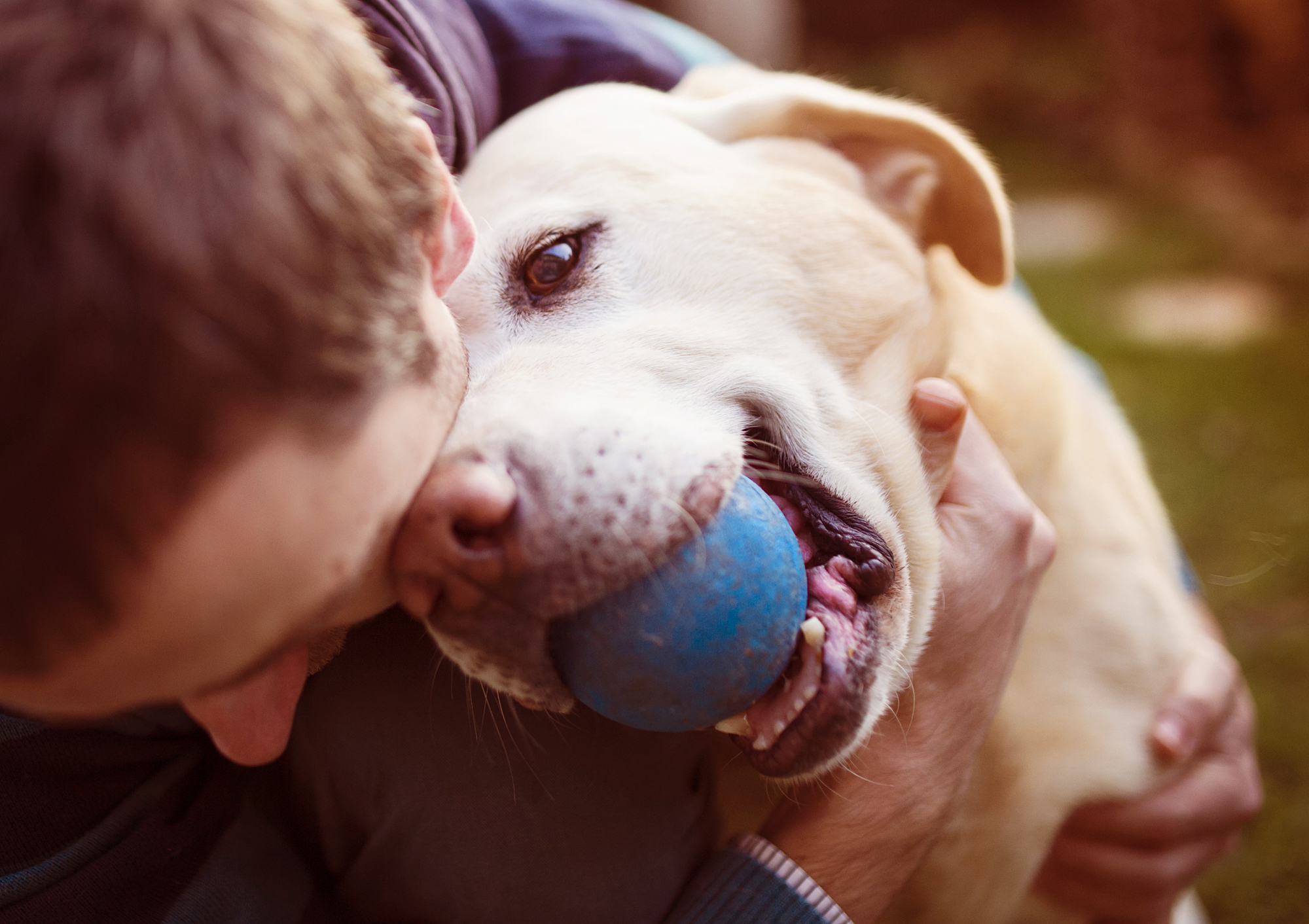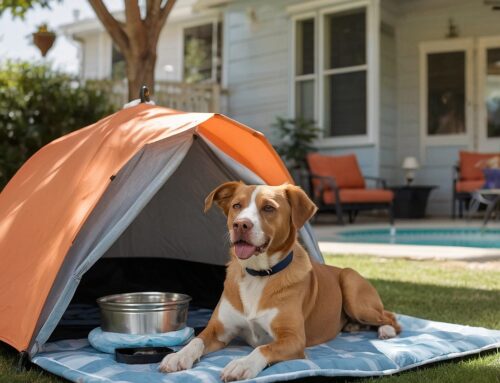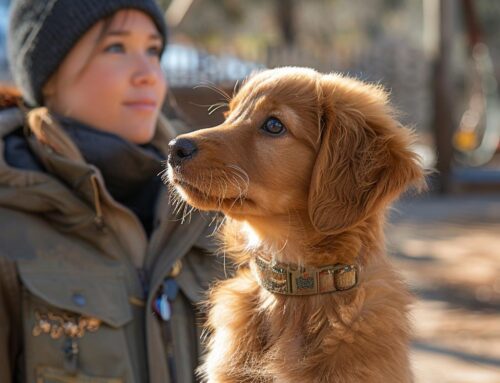Dog owners likely know that dogs are fun pets to play with and be around, but did you know there are real mental and physical health benefits to owning a dog?
Physical Benefits
It may seem obvious, but most dogs are natural exercisers. They love to walk, run, jump, explore and play fetch. Swimming, also, is another favorite dog activity. If you own a dog, it’s almost a given that you’ll be doing these things too when you take your dog out.
Along the way, you’ll likely boost your vitality, reduce your stress, lower your blood pressure, decrease your triglycerides and cholesterol levels and elevate your serotonin and dopamine, which are all great for improving your mood (see below).
Studies show that dog owners who are over age 65 make 30 percent fewer visits to the doctor than people who don’t have dogs. They also show that those owners who have experienced heart attacks tend to live longer than those people who don’t have dogs.
Mental Benefits
Beyond physical benefits, which may seem more obvious, there are also mental benefits to owning a dog. First and foremost of these is companionship, which has been shown to improve the life of just about anyone, but it’s particularly helpful for seniors and empty nesters who otherwise might be lonely or missing someone in their life.
Not only does a dog serve as a faithful companion, but its typically gregarious nature is a perfect conversation starter and a great way to meet new people — especially other dog owners — when you go out. Companionship helps to reduce anxiety and add meaning and purpose to a dog owner’s life; for many people, dogs add structure and routine to a day. As mentioned above, mood is often improved by having a furry friend around who’s always excited to spend time with you; those who suffer from depression, for instance, can’t help but have their spirits lifted by dogs.
The power of touch has been shown to have both mentally and physically therapeutic effects; it’s a basic human need that dogs can fulfill, helping to soothe spirits and promote calm. It’s been proven that even hardened criminals have had changes to their life outlook once they were introduced to dogs for the first time, facilitating meaningful affection — sometimes for the first time in these people’s lives. Studies have shown that people suffering from dementia or Alzheimer’s disease are aided by the presence of dogs.
Benefits for Children
Besides seniors, kids can also benefit from having a dog around. While many people in children’s lives can be unduly critical (parents, teachers, friends), dogs never judge and don’t make children feel bad; in fact, they usually do just the opposite. Dogs can provide a sense of security and ease separation anxiety in children when parents or other guardians aren’t around. Dogs can make a child feel loved and important, helping them to develop a positive self-image. Kids can talk to their dog without the fear of rejection, allowing them to build confidence and even improve their reading skills and vocabulary. Children who form strong bonds with their dogs are also likely to forge strong relationships with the people in their lives.
Dogs can teach children about the importance of empathy, understanding and responsibility. At the same time, a dog can stimulate a child both physically and mentally and can even be a doorway to learning, expanding imaginations and curiosity. Teaching a dog a new trick can show a child the value and importance of perseverance.
In hyperactive or aggressive children, dogs have been shown to reduce mood swings and induce calm. Children who are autistic tend to do better interacting with dogs than with people. Dogs can help children afflicted with learning disabilities to stay alert and attentive; they can also help a child deal with the frustrations that these disabilities can bring.
Selecting the Right Breed of Dog
Bearing all of the above in mind, certain breeds of dogs are better than others for improving and maintaining one’s physical and mental health. Particularly active dog breeds include American Staffordshire Terriers, Border Collies, Brittanys, Dalmations, Doberman Pinschers, German Shorthaired Pointers, Greyhounds, Redbone Coonhounds and Vizslas. But be aware that keeping up with some of these dogs can be a real effort at times; many of them are happiest when they have a reasonable amount of stimulation. Running, hiking, swimming and hunting are great activities for these dogs to join you in.
For mental stimulation and mood improvement, a Vizsla, Labrador Retriever, Yorkshire Terrier, Pug, Cavalier King Charles’ Spaniel, Brussels Griffon, Golden Retriever, Corgi, Irish Wolfhound or Chihuahua dog can be ideal. These dogs tend to be intelligent, loving, playful and loyal.
Other factors in selecting the right dog breed include the amount of space in your home or yard, how much time you have available to spend with a dog, whether or not you have children and how much shedding of hair you can tolerate.
Training Is Important
In contrast to the above types of dogs, there are some breeds that can be challenging (reactive tendencies), particularly if they’re not socialized and trained from a young age. These include but are not limited to German Shepherds, Belgian Malinois, American Pit Bull Terriers, Siberian Huskies, Dachshunds, Rottweilers, Jack Russell Terriers, Akitas, Chihuahuas, Chow Chows, Dalmatians and Shar Peis. Training a dog will have a big impact on seeking harmony in a pet relationship, as well as a dog’s reaction to strangers and new environments.
All dogs require time and attention, so before you get a dog, ask yourself if you can handle the responsibility of owning one. Dogs can only be left alone for a limited time. Dogs that have been locked up in a house all day may not provide any therapeutic benefits at all; dogs need exercise daily to stay well-balanced and calm.
But beyond physical stimulation, training provides mental stimulation for dogs. Stimulated dogs are happy dogs. The ideal window for training dogs is when they’re puppies, especially between three and 17 weeks old. This period of time is critical for dogs to become well-socialized. It’s vital that all dogs learn essential obedience skills such as recall under distraction, go to your place commands, and leash etiquette out and about in public. Performance K9 Training has helped numerous parents achieve top-notch obedience skill goal








